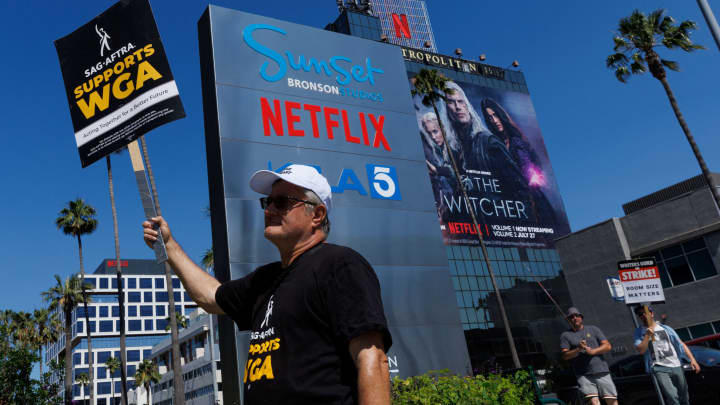
(CNBC) Traditional TV is dying. Ad revenue is soft. Streaming isn’t profitable. And Hollywood is practically shut down as the actors and writers unions settle in for what is shaping up to be a long and bitter work stoppage.
All of this turmoil will be on investors’ minds as the media industry kicks off its earnings season this week, with Netflix up first on Wednesday.
Netflix, with a new advertising model and push to stop password sharing, looks the best positioned compared with legacy media giants. Last week, for instance, Disney CEO Bob Iger extended his contract through 2026, telling the market he needed more time at the Mouse House to address the challenges before him. At the top of the list is contending with Disney’s TV networks, as that part of the business appears to be in a worse state than Iger had imagined. “They may not be core to Disney,” he said.
“I think Bob Iger’s comments were a warning about the quarter. I think they are very worrying for the sector,” said analyst Michael Nathanson of SVB MoffettNathanson following Iger’s interview with CNBC’s David Faber on Thursday.
Although the soft advertising market has been weighing on the industry for some quarters now, the recent introduction of a cheaper, ad-supported option for services like Netflix and Disney+ will likely be one bright spot as one of the few areas of growth and concentration this quarter, Nathanson said.
Iger has talked at length in recent investor calls and Thursday’s interview about how advertising is part of the plan to bring Disney+ to profitability. Others, including Netflix, have echoed the same sentiment.
Netflix is scheduled to report earnings after the close Wednesday. Wall Street will be keen to hear more details about the rollout of its password sharing crackdown in the U.S. and state of its newly launched ad-supported option. The company’s stock is up nearly 50% this year, after a correction in 2022 that followed its first subscriber loss in a decade.
Investor focus will also be on legacy media companies like Paramount Global, Comcast and Warner Bros. Discovery, which each have significant portfolios of pay-TV networks, following Iger’s comments that traditional TV “may not be core” to the company and all options, including a sale, were on the table. These companies and Disney will report earnings in the weeks ahead.
Strike woes

Scene from “Squid Game” by Netflix
Source: Netflix
Just a week ahead of the earnings kickoff, members of The Screen Actors Guild – American Federation of Television and Radio Artists joined the more than 11,000 already striking film and television writers on the picket line.
The strike – a result of the failed negotiations with the Alliance of Motion Picture and Television Producers – brings the industry to an immediate halt. It’s the first dual strike of this kind since 1960.
The labor fight blew up just as the industry has moved away from streaming growth at all costs. Media companies saw a boost in subscribers – and stock prices – earlier in the Covid pandemic, investing billions in new content. But growth has since stagnated, resulting in budget cuts and layoffs.
“The strike happening suggests this is a sector in tremendous turmoil,” said Mark Boidman, head of media and entertainment investment banking at Solomon Partners. He noted shareholders, particularly hedge funds and institutional investors, have been “very frustrated” with media companies.
Iger told CNBC last week the stoppage couldn’t occur at a worse time, noting “disruptive forces on this business and all the challenges that we’re facing,” on top of the industry still recovering from the pandemic.
These are the first strikes of their kind during the streaming era. The last writers strike occurred in 2007 and 2008, which went on for about 14 weeks and gave rise to unscripted, reality TV. Hollywood writers have already been on strike since early May of this year.
Depending on the longevity of the strike, fresh film and TV content could dry up and leave streaming platforms and TV networks – other than library content, live sports and news – bare.
For Netflix, the strikes may have a lesser effect, at least in the near term, Insider Intelligence analyst Ross Benes said. Content made outside the U.S. isn’t affected by the strike — an area where Netflix has heavily invested.
“Netflix is poised to do better than most because they produce shows so well in advance. And if push comes to shove, they can rely on international shows, of which they have so many,” said Benes. “Netflix is the antagonist in the eyes of strikes because of how it changed the economics of what writers get paid.”
Traditional TV doom

The decline of pay-TV subscribers, which has ramped up in recent quarters, should continue to accelerate as consumers increasingly shift toward streaming.
Yet, despite the rampant decline, many networks remain cash cows, and they also supply content to other parts of the business — particularly streaming.
For pay-TV distributors, hiking the price of cable bundles has been a method of staying profitable. But, according to a recent report from MoffettNathanson, “the quantity of subscribers is falling far too fast for pricing to continue to offset.”
Iger, who began his career in network TV, told CNBC last week that while he already had a “very pessimistic” view of traditional TV before his return in November, he has since found it’s even worse than he expected. The executive said Disney is assessing its network portfolio, which includes broadcaster ABC and cable channels like FX, indicating a sale could be on the table.
Paramount is currently considering a sale of a majority stake in its cable-TV network BET. In recent years Comcast’s NBCUniversal has shuttered networks like NBC Sports and combined sports programming on other channels like USA Network.
“The networks are a dwindling business, and Wall Street doesn’t like dwindling businesses,” said Nathanson. “But for some companies, there’s no way around it.”
Making matters worse, the weak advertising market has been a source of pain, particularly for traditional TV. It weighed on the earnings of Paramount and Warner Bros. Discovery in recent quarters, each of which have big portfolios of cable networks.
Advertising pricing growth, which has long offset audience declines, is a key source of concern, according to MoffettNathanson’s recent report. The firm noted that this could be the first nonrecessionary year that advertising upfronts don’t produce increases in TV pricing, especially as ad-supported streaming hits the market and zaps up inventory.
Streamers’ introduction of cheaper, ad-supported tiers will be a hot topic once again this quarter, especially after Netflix and Disney+ announced their platforms late last year.
“The soft advertising market affects everyone, but I don’t think Netflix is as affected as the TV companies or other established advertising streamers,” said Benes. He noted while Netflix is the most established streamer, its ad tier is new and has plenty of room for growth.
Advertising is now considered an important mechanism in platforms’ broader efforts to reach profitability.
“It’s not a coincidence that Netflix suddenly became judicious about freeloaders while pushing a cheaper tier that has advertising,” said Benes, referring to Netflix’s crackdown on password sharing. “That’s pretty common in the industry. Hulu’s ad plan gets more revenue per user than the plan without advertising.”
Are more mergers coming?
Last week’s ruling from a federal judge that Microsoft‘s $68.7 billion acquisition of game publisher Activision Blizzard should move forward serves as a rare piece of good news for the media industry. It’s a signal that significant consolidation can proceed even if there’s temporary regulatory interference.






